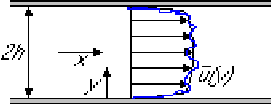Channel Flow

Assuming a long duct, the velocity-related quantities and the pressure
gradients will be independent of ![]() , just like for the laminar case.
That makes turbulent duct flow simpler than turbulent boundary layers,
where the streamwise gradients are smaller than the transverse ones,
but not zero. Consider how the Reynolds-averaged Navier-Stokes
equations simplify for the duct:
, just like for the laminar case.
That makes turbulent duct flow simpler than turbulent boundary layers,
where the streamwise gradients are smaller than the transverse ones,
but not zero. Consider how the Reynolds-averaged Navier-Stokes
equations simplify for the duct:
Continuity
The ![]() -momentum equation can easily be integrated to give
-momentum equation can easily be integrated to give
If we put the above pressure into the ![]() -momentum equation, noting
that
-momentum equation, noting
that ![]() as a velocity quantity is independent of
as a velocity quantity is independent of
![]() , we get:
, we get:
Now a turbulent flow will dissipate much more kinetic energy than a laminar one under the same conditions. The irreversible loss of kinetic energy must come from a much larger pressure gradient pushing the flow through the duct. But since the net force on the fluid must be zero, the shear force exerted by the wall on the fluid must be much greater too. In short, in the above equation, both the pressure gradient and the net shear stress are much larger than in the laminar case.
Now at the walls, the Reynold stress ![]() =
=
![]() is zero because of the wall boundary condition
on the velocity. So there must be a very large laminar stress
is zero because of the wall boundary condition
on the velocity. So there must be a very large laminar stress
![]() at the walls. And since
at the walls. And since ![]() =
=
![]() , the velocity profile must be
varying extremely rapidly near the walls. But, since the profile is
monotonous to the center, this can only be true in a thin layer,
called the
, the velocity profile must be
varying extremely rapidly near the walls. But, since the profile is
monotonous to the center, this can only be true in a thin layer,
called the surface layer,
at each of the two walls.
Outside these layers, the Reynolds stress must dominate and the
laminar stress can be ignored.
Exercise:
Sketch the velocity profiles for laminar and turbulent flow with the same mass flow through the duct. Indicate the layer near the wall and how it is different from the laminar flow case.
By convention, the magnitude of the shear stress at the wall is
written in terms of a ``friction velocity'' ![]() :
:
It seems reasonable to assume that in the thin surface layers, the
large-scale features of the flow are only evident through the stress
they impose, as measured by ![]() . So if we take
. So if we take ![]() to be the
distance from the wall, we can assume that
to be the
distance from the wall, we can assume that

viscous sublayer.
In the center region of the duct, in between the two surface layers,
the picture to keep in mind is that the strong turbulent mixing would
create a uniform velocity profile if there were no walls. However,
the surface layers exert a shear force, measured by ![]() , on the edges
of the center region, preventing the uniform profile to fully develop.
It seems reasonable then to assume that the deviation from a uniform
profile is functionally given by
, on the edges
of the center region, preventing the uniform profile to fully develop.
It seems reasonable then to assume that the deviation from a uniform
profile is functionally given by
Now consider some hypothetical thin layer, close to the bottom wall,
but still well above the still thinner surface layer. In such a
layer, both the law of the wall (for ![]() relatively
large) and the velocity defect law (for
relatively
large) and the velocity defect law (for ![]() ) must be
valid. Such a layer, in which two different expressions are both
valid, is called a
) must be
valid. Such a layer, in which two different expressions are both
valid, is called a matching layer.
For turbulent
boundary layers, the matching region is referred to as the
inertial sublayer.
(But “inertial
region” would have been a more accurate name since a matching
region has no clearly defined boundaries. Note also that by
definition the inertial sublayer has to be thick compared to the
surface layer below it and thin compared to the duct size.)
If both the law of the wall and the velocity defect law must be valid
in the inertial sublayer, then their ![]() derivatives must match too.
Writing that out gives:
derivatives must match too.
Writing that out gives:
The two expressions above can now be integrated to give the shape of
the velocity profile in the inertial sublayer:

Substracting the two equations above, we get the ``logarithmic
friction law'':

Exercise:
Discuss figure 26.13 and how it verifies and does not verify the above discussion for the case of a boundary layer.